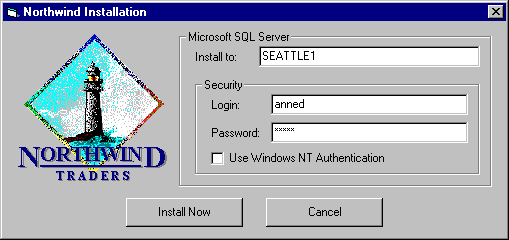
A SQL-DMO application creates a SQLServer object and uses the Connect method when a session is required on a specific Microsoft® SQL Server™ installation. Some applications may create only a single SQLServer object, using it for all interaction with a server. Others may create multiple SQLServer objects, connected to one or more servers, providing multiple server administration functions.
SQL-DMO offers application developers flexibility in locating servers as administration targets. Regardless of the method used to identify a server, the application creates a new SQLServer object for each session.
For example, an installation routine may collect a SQL Server installation name, a system administrator user identifier, and a password as part of its functioning, as shown in the illustration.

A Microsoft Visual Basic® installation routine using the example dialog box and the Connect method of a SQLServer object might look something like:
Private Sub cmd_Install_Click()
On Error GoTo ErrorHandler
Dim oSQLServer As New SQLDMO.SQLServer
Dim bConnected As Boolean
bConnected = False
oSQLServer.LoginTimeout = 30
If chk_Integrated.Value = 1 Then
oSQLServer.LoginSecure = True
oSQLServer.Connect txt_SQLServer.Text
Else
oSQLServer.Connect txt_SQLServer.Text, txt_Login.Text, _
txt_Password.Text
End If
' ... do installation ...
oSQLServer.DisConnect
Exit Sub
ErrorHandler:
MsgBox (Err.Description)
If bConnected = True Then
oSQLServer.DisConnect
End If
End Sub
Another application automating backup by using organization standard backup media and procedures may query the RegisteredServers collection of the Application object, returning the list of user-registered servers in a combo box or other control allowing selection. Based on user action, the application would use the properties of the selected RegisteredServer object when using the Connect method of a SQLServer object.
Likewise, an application could use the ListAvailableSQLServers method of the Application object to locate all SQL Server installations in an organization.